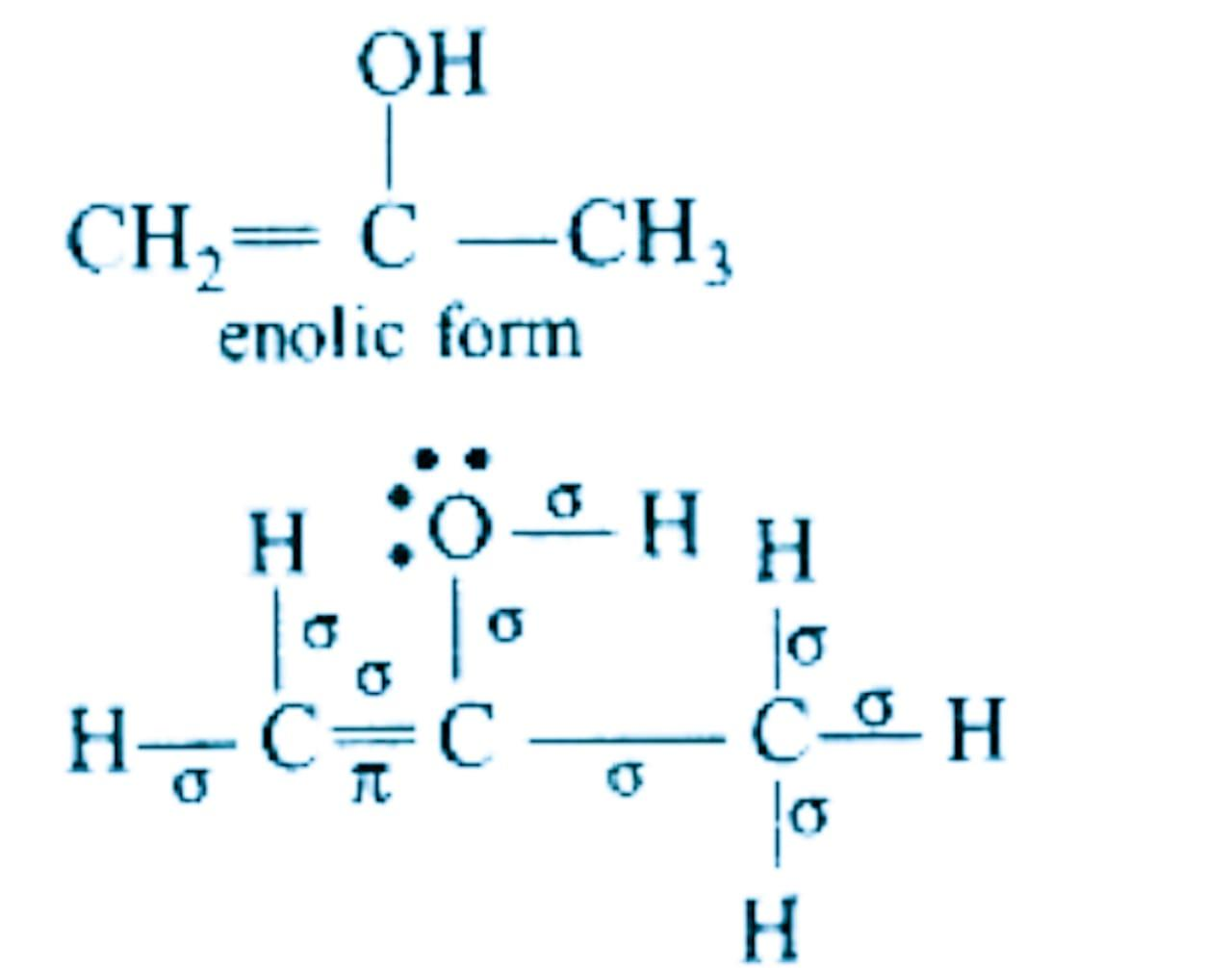
The enolic form of acetone contains: -
(a)- \[10\sigma -bonds\text{ }2\pi -bonds\text{ }and\text{ }1\text{ }lonepair\]
(b)- \[9\sigma -bonds\text{ }2\pi -bonds\text{ }and\text{ 2 }lonepairs\]
(c)- \[8\sigma -bonds\text{ }2\pi -bonds\text{ }and\text{ 2 }lonepairs\]
(d)- \[9\sigma -bonds\text{ 1}\pi -bond\text{ }and\text{ 2 }lonepairs\]
Answer
218.7k+ views
Hint: For the enolic form, the oxy group changes to the hydroxyl group. The double bond shifts from carbon-carbon to carbon-oxygen. Enolic form occurs because of a special type of bonding.
Complete step by step answer:
In simple aldehydes and ketones like acetaldehyde, acetone, etc., the amount of enolic form is negligibly small. However, if the enolic form is stabilized by intramolecular hydrogen bonding or resonance, the amount of enolic form is much greater than the keto form.
In acetone, the enolic form is stabilized by intramolecular hydrogen-bonding.
The formula of acetone is \[C{{H}_{3}}-CO-C{{H}_{3}}\]
It is the ketonic form.
The formula of the enolic form of acetone is \[C{{H}_{2}}=C(OH)-C{{H}_{3}}\].
The occurrence of keto-enol form is because of tautomerism. It is a special kind of functional isomerism in which the isomers exist in dynamic equilibrium with each other. It arises due to the migration of a hydrogen atom from one polyvalent atom to the other within the same molecule with the necessary rearrangement of linkages. The isomers obtained are called tautomers.

In the compound above there are \[9\sigma -bonds\].
There is \[\text{1}\pi -bond\], which has shifted from carbon-oxygen double bond in keto form to carbon-carbon double in enol form.
There are 2 lone pairs on the oxygen atom.
Hence, the correct option is (d)- \[9\sigma -bonds\text{ 1}\pi -bond\text{ }and\text{ 2 }lonepairs\].
Note: You may get confused between ketonic and enolic form. While converting ketonic to enolic form or vice-versa the valency of each atom should be checked and completed, to avoid the mistake.
Complete step by step answer:
In simple aldehydes and ketones like acetaldehyde, acetone, etc., the amount of enolic form is negligibly small. However, if the enolic form is stabilized by intramolecular hydrogen bonding or resonance, the amount of enolic form is much greater than the keto form.
In acetone, the enolic form is stabilized by intramolecular hydrogen-bonding.
The formula of acetone is \[C{{H}_{3}}-CO-C{{H}_{3}}\]
It is the ketonic form.
The formula of the enolic form of acetone is \[C{{H}_{2}}=C(OH)-C{{H}_{3}}\].
The occurrence of keto-enol form is because of tautomerism. It is a special kind of functional isomerism in which the isomers exist in dynamic equilibrium with each other. It arises due to the migration of a hydrogen atom from one polyvalent atom to the other within the same molecule with the necessary rearrangement of linkages. The isomers obtained are called tautomers.

In the compound above there are \[9\sigma -bonds\].
There is \[\text{1}\pi -bond\], which has shifted from carbon-oxygen double bond in keto form to carbon-carbon double in enol form.
There are 2 lone pairs on the oxygen atom.
Hence, the correct option is (d)- \[9\sigma -bonds\text{ 1}\pi -bond\text{ }and\text{ 2 }lonepairs\].
Note: You may get confused between ketonic and enolic form. While converting ketonic to enolic form or vice-versa the valency of each atom should be checked and completed, to avoid the mistake.
Recently Updated Pages
Chemical Properties of Hydrogen - Important Concepts for JEE Exam Preparation

JEE General Topics in Chemistry Important Concepts and Tips

JEE Atomic Structure and Chemical Bonding important Concepts and Tips

JEE Amino Acids and Peptides Important Concepts and Tips for Exam Preparation

JEE Extractive Metallurgy Important Concepts and Tips for Exam Preparation

Algebra Made Easy: Step-by-Step Guide for Students

Trending doubts
JEE Main 2026: Application Form Open, Exam Dates, Syllabus, Eligibility & Question Papers

Derivation of Equation of Trajectory Explained for Students

Hybridisation in Chemistry – Concept, Types & Applications

Understanding the Angle of Deviation in a Prism

Understanding Collisions: Types and Examples for Students

Understanding Atomic Structure for Beginners

Other Pages
NCERT Solutions For Class 11 Chemistry Chapter 7 Redox Reaction

JEE Advanced Marks vs Ranks 2025: Understanding Category-wise Qualifying Marks and Previous Year Cut-offs

Thermodynamics Class 11 Chemistry Chapter 5 CBSE Notes - 2025-26

NCERT Solutions ForClass 11 Chemistry Chapter Chapter 5 Thermodynamics

Equilibrium Class 11 Chemistry Chapter 6 CBSE Notes - 2025-26

How to Convert a Galvanometer into an Ammeter or Voltmeter




